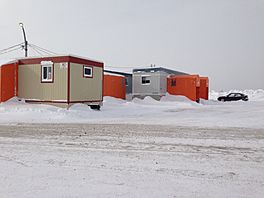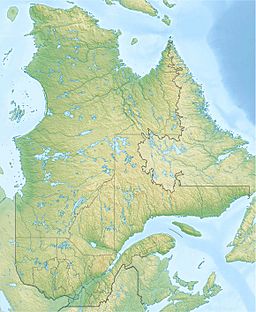Fire Lake, Quebec facts for kids
Quick facts for kids Fire Lake |
|
|---|---|

Mining camp at Fire Lake
|
|
| Location | Rivière-Mouchalagane, Quebec, Canada |
| Coordinates | 52°20′13″N 67°21′41″W / 52.336913°N 67.361417°W |
| Native name | Lac Fire Error {{native name checker}}: parameter value is malformed (help) |
| Basin countries | Canada |
| Max. length | 2.6 kilometres (1.6 mi) |
| Max. width | 800 metres (2,600 ft) |
Fire Lake, also known as French: Lac Fire in French, is a lake located in the Côte-Nord region of Quebec, Canada. This lake is famous for its large open-pit iron mine. Mining here was very active in the 1970s and 1980s. After a break of twenty years, a company called ArcelorMittal started mining again in 2006.
Discovering Fire Lake's Location
Fire Lake is about 2.6 kilometers (1.6 miles) long and 800 meters (2,600 feet) wide. It is located far north in Quebec, Canada. The lake is about 400 kilometers (250 miles) north of Port-Cartier, a city with a port on the Gulf of Saint Lawrence. It is also 85 kilometers (53 miles) southeast of the town of Fermont.
The lake is in an area called Rivière-Mouchalagane, which is not officially organized into towns. It is part of the Caniapiscau Regional County Municipality. You can find Fire Lake just west of Quebec Route 389 and the Cartier Railway. The Québec Cartier Mining Company named Fire Lake in the 1950s. They were exploring the area around the lake at that time.
The land around Fire Lake is mostly boggy, which means it is wet and marshy. Other lakes nearby include Lac Bergeron to the north, Lac Hope to the east, and Lac Hobdad to the west. The water in this region flows into the Petite rivière Manicouagan.
Exploring the Fire Lake Mining Operation
The Québec Cartier Mining Company started mining iron at Lake Jeannine in 1961. This mine was southwest of Fire Lake, near the town of Gagnon, which the company built. In the 1970s, the company invested in new mining sites. These included Mont-Wright, Fermont, and Fire Lake.
An open-pit mine near Fire Lake was operated by Sidbec-Normines. This was a group of private and public companies. They mined there between 1977 and 1984. Before mining began, facilities were built around the small settlement of Fire Lake from 1971 to 1977. A road was also built to connect Fire Lake to Gagnon, which was 84 kilometers (52 miles) away.
About 54 million tonnes of iron were taken from Fire Lake. This iron was turned into pellets of iron and silica. These pellets were then sent to the Port Cartier plant. From there, most of the iron was shipped to countries in Europe. The Lake Jeannine iron mine closed in 1976. The Fire Lake mine also closed in 1984. However, the mill at Lake Jeannine continued to process iron ore from Fire Lake until 1985. Both the settlement of Fire Lake and the town of Gagnon were abandoned in 1985.
Modern Mining at Fire Lake
ArcelorMittal started mining at Fire Lake again in 2006. At first, operations would stop each winter. But in 2012, they began mining all year round. The iron ore found at Fire Lake is of higher quality than the ore from the Mont-Wright mine. The Mont-Wright mine is 55 kilometers (34 miles) to the north.
The Fire Lake site does not have a crusher or a concentrator. These are machines that process the raw ore. Instead, the raw ore is shipped by train to Mont-Wright for processing. Trains usually make four trips a day, with about 60 wagons each time. After the ore is crushed and concentrated at Mont-Wright, it is taken by train to Port-Cartier.
Another mine, Fire Lake North, is next to ArcelorMittal's property. It is operated by Champion Iron. This mine is estimated to have a huge amount of high-quality iron ore, about 3.4 billion tonnes. Fire Lake is one of four active mines in the Fermont Iron Ore District. These mines produce all of Canada's iron ore. In 2013, it was estimated that this district produced 47 million tonnes of iron ore concentrate.
As of 2017, ArcelorMittal Mining Canada G.P. owned 85% of the Fire Lake mine. The rest was owned by a group of companies. These included the South Korean POSCO and China Steel. The mine had 66 employees working there.


